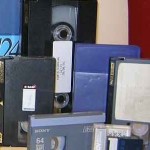You may have already read our extremely popular article on Subconscious reading techniques. So you should already know that you don’t need to understand everything or even comprehend everything you read on the first pass. All that matters is that you “SEE” the text on the page. It seems strange but your mind is extremely powerful, just let the words wash through your eye/brain combination. Your mind will do the rest in helping you comprehend the material.
This article is a book review on Home VCR Repair Illustrated by Richard C. Wilkins and Cheryl A. Hubbard. They did an outstanding job with the text and the informative diagrams and pictures in this book. The authors present a technically dense repair book in a casual reading format. It is filled with electronics jargon and terminology and detailed steps. But you probably already guessed that for yourself.
One question you’re probably thinking is: “Why would anyone read a 400 page repair book for a technology that isn’t even sold anymore in major stores?”
Here’s the answer: Information does not need to be relevant in order to have tremendous value.
Think about it. People learn from history all the time. It isn’t up-to-date information, but the battles, lost loves and adventures stir the heart and we learn from old stories.
The same thing goes for technical information. By allowing obsolete and “retro” technology into our hearts we can have a deeper appreciation for the scientific method of repair, and also a better understanding of step-by-step processes and troubleshooting.
In Home VCR Repair Illustrated, there is an awesome glossary at the back. It is simply filled with 2 pages of simple-yet punchy terminology that could have value to any technology enthusiast or perhaps even an aspiring electrician.
Almost every other page has a black and white picture of the insides of a VCR. Trying to find the specific thing that Wilkins is talking about in the pictures is like engaging in a cyber-punk Where’s Waldo with a 1970’s hipster twist. When I say “1970’s hipster” I’m referring to a modern hipster which is into 1970’s tech as opposed to what a hipster may have been like in the 1970’s – there’s a difference.
Do you ever repair stuff?
If not then why not? Don’t you play computer games? The repair skill is one of the most important skills in Fallout games. It’s next only to speech and healing skills. All I’m saying, is…if repairing stuff wasn’t fun, then humans probably wouldn’t be equipped with grabby little fingers.
OH! I almost forgot. The parts inside old VCR’s are actually pretty cool! Even broken ones can have neat things in them.
For example: There’s motors, metal rods and sometimes even rubber bands (not the flimsy ones but the dense ones used for motors etc.) which can be used in other cool projects. If you’re a kid reading this then make sure and have your pop’s help you with your adventures in technology. It’s always a good bonding experience to work with technology with the parents. They have bigger and clumsier hands than you. That’s part of the reason why children were used in the industrial revolution as workers. They could get inside machinery and fix things that the adults couldn’t without sophisticated tools. But all the child issues with kids getting stuck in the large industrial machines is what was part of the general push towards workers rights in the 1900’s. That’s just a side note, but be safe!
I loved this book a great deal and I think you will too. I’m going to donate this book today but I kept the glossary for myself.
-Tyler



